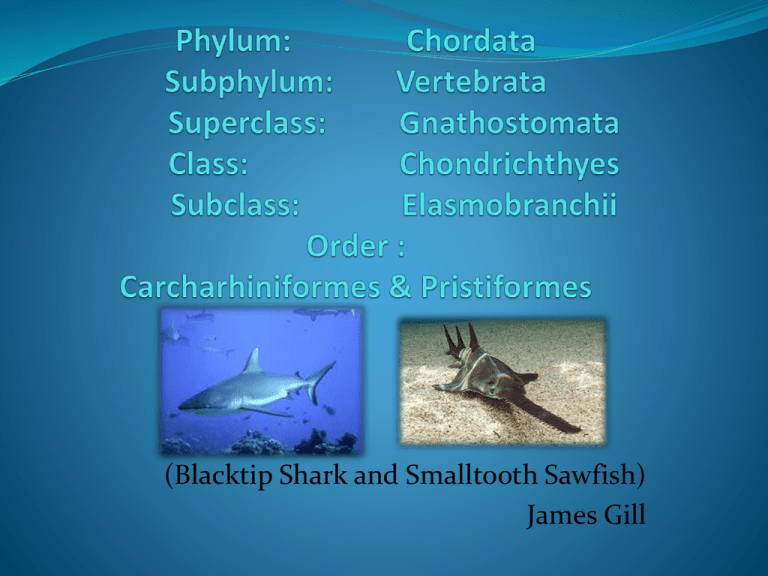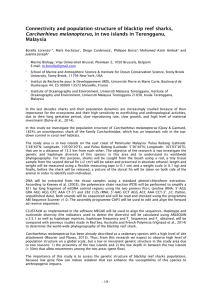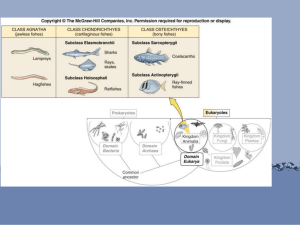
(Blacktip Shark and Smalltooth Sawfish)
James Gill
Order Carcharhiniformes:
Largest Order of sharks containing 270
different species including catsharks,
swellsharks, and the sandbar shark
Known as ground sharks
Nictitating membrane over each eye
Two dorsal fins
An anal fin
Five gill slits
Family
Family Carcharhinidae:
Known as Requiem Sharks
Migratory
Live-bearing sharks (viviparous)
Responsible for most attacks on humas
Live in warm seas
Blacktip Shark
(Carcharhinus limbatus)
Biological Facts:
Fun Facts:
Females are viviparous, usually bearing 4-7
pups
Usually grow to be about 4.9ft long
90% of their diet is fish, the other 10% being
crustaceans and cephalopods
Favored habitats are island lagoons, muddy
bays coral reef drop-offs and mangrove
swamps.
Most active at dawn and dusk
Usually live in sexually segregated schools until
mating season
Most bites can be pinned on blacktip sharks
but there has never been a recorded fatal
incident.
Seasonal migration from North Carolina in the
summer to Florida in the winter off the east
coast of the US
Nearly threatened but not endangered
Known to jump out of the water and spin in
order to disorient schools of fish for feeding
http://www.youtube.com/watch?v=Rzxob3G_3G0
Known to utilize asexual reproduction when
no males are present (automictic
parthenogenesis)
Most timid of the large Requiem Sharks and
will observe humans from a safe distance.
Blacktip VS Blacktip REEF sharks
Blacktip:
Blacktip Reef:
Carcharhinus limbatus
Carcharhinus melanopterus
Timid but curious, will watch humans
Timid and skittish, very difficult to
approach
Closer to reef drop-offs, sometimes
mangrove swamps
Usually 4.9 feet
Shallow inshore waters and sandy flats
Usually 5.3 feet
Order Pristiformes:
• Known as carpenter
sharks
• Only 1 living
family(Pristidae) and 7
species
• long, narrow, flattened
rostrum
Biological Facts:
Females are ovoviviparous
Little is known about the reproduction
habits of the sawfish. They are estimated
to mate once every two years, with an
average litter of around eight. They
mature very slowly (12 years) with low
reproduction rates
Usually 7.6 meters in length
Small fish, crustaceans and mollusks
shallow tropical and subtropical waters
in coastal parts of the Atlantic
All species are nocturnal
Rostrum is used for a multitude of
purposes
All species are critically endangered
Differences between sawFISH and
sawSHARKS
Sawfish:
Sawsharks:
Gill openings on sides
Barbels
Alternating large and small saw
Gill openings on underside
No barbels
All teeth are the same size
Shallow, costal waters
Relatively large (up to 23feet)
teeth
Deep offshore waters
Relatively small (about 5feet)
Fun with Rostrums- a Multi Purpose tool
A sawfish’s saw is made up of thousands of sensory organs that allow them to monitor the
movements of other organisms by measuring the electrical fields they emit. Because the
sensory organs are more densely packed on the dorsal side of its saw, the fish can create an
image of the three-dimensional area above it, even in waters of low-visibility, which helps
explain its bottom-dwelling nature. Utilizing their saw as an extended sensing device,
sawfish are able to “view” their entire surroundings by maintaining a position low to the sea
floor.
Smalltooth sawfish have been observed to approach large shoals of fish while striking their
saw rapidly from side to side. The sawfish has also been observed to attack larger prey by
using their weapon to dislodge large pieces of meat from victims. They then use their
serrated saw teeth to tear through flesh.
The rostrum’s “teeth” are called deticles. Because the fish can swing its body so quickly, it
also acts as a defense mechanism to scare predators away.
The pups’ rostral blades are enclosed by a sheath – so as to protect the mother during the
birthing process – which eventually disintegrates and falls off.












